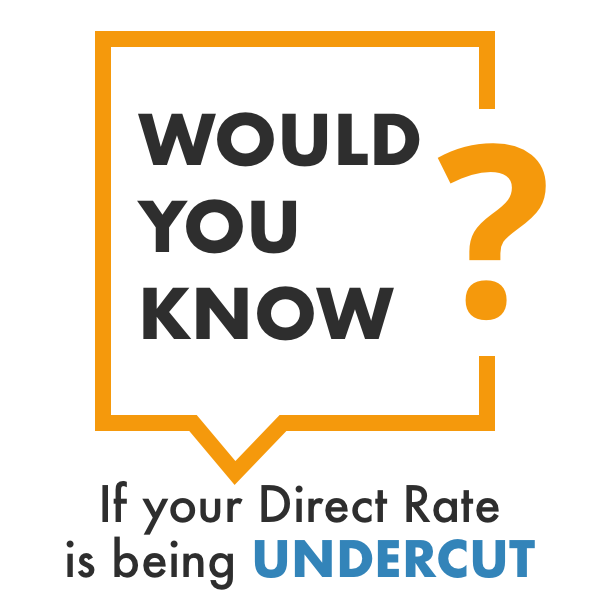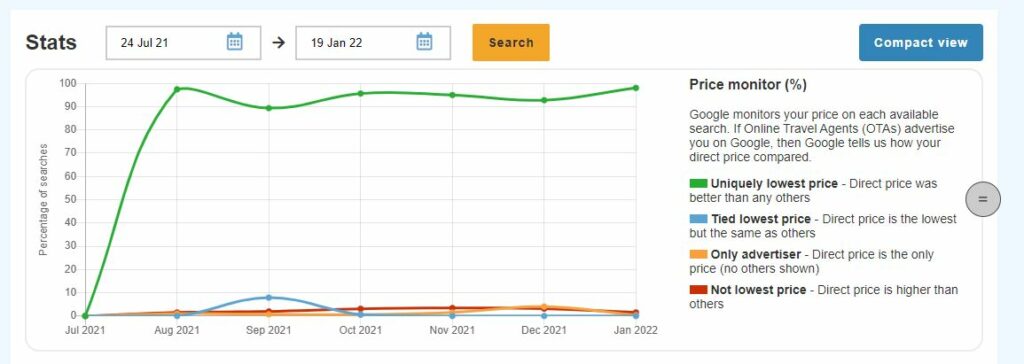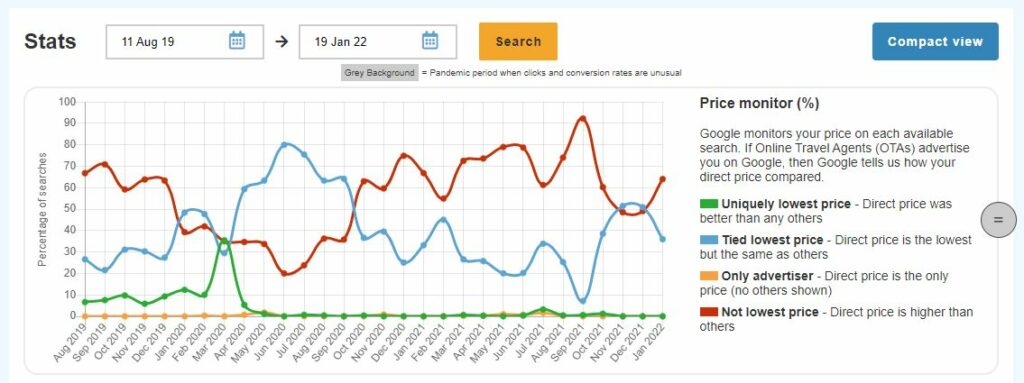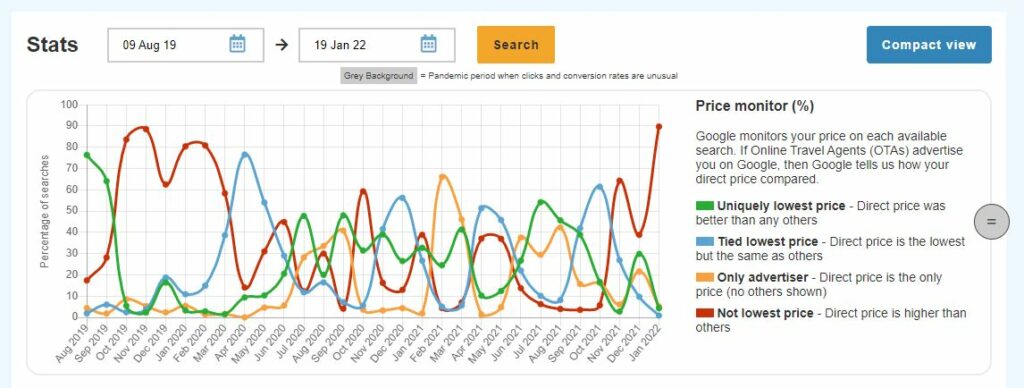
Get the GuestTappy app
Scan the QR code to download the app
Know if your direct price is being undercut, measure it and control it

If you’re failing at direct bookings it’s likely that your price competitiveness is bad. If the channels are offering guests a better price wouldn’t you want to know about it? But nobody wants to search date after date to find out how their direct rate compares and the channels won’t tell you if your direct rate is higher than their rate – (spoiler alert) we will tell you…read on.
Google Hotel Ads graphs measure your price competitiveness and show how your direct rate compares every time a potential guest makes a search.
Google has a goldmine of data on searches, they record them all, night and day. We have taken that data and made it into graphs for you because we know how important it is. Getting your direct price right improves your profitability, and getting it wrong loses you money. Not knowing either way could be a hidden cost and an expensive one.
These graphs provide information you can act upon, a clear picture of how in control of your own prices you actually are. It may seem like an easy thing to get right but the data shows that many businesses are losing direct bookings because they’re getting it wrong. After all, who is going to book direct if it’s cheaper to book with an OTA, and vice versa.
More Direct Bookings
Real time information collected, updated and constantly displayed giving you more control than ever.
Welcome to the price monitor showing what percentage of searches on Google Hotel Ads fall into each of these four categories:
Uniquely lowest price – your direct price was lower than all other prices displayed for that search, which includes prices for your property on the OTAs. This is the green line and you want this to be case on the vast majority of searches.
Tied lowest prices – your direct price is the lowest but there are other booking channels with that same price. This is the blue line and it means guests don’t have a big incentive to book direct because they can get the same price on the OTAs.
Only advertiser – your direct price is the only price shown, there are no other prices to compare it with. This is the amber line and happens if you are not with any OTAs or have closed out their availability for the date the customer searches.
Not lowest price – your direct price is more expensive than other channels, this is very bad for your direct bookings. When the red line shows it’s a big disincentive for a guest to book directly with you because your rate is lower on the OTAs. Happy OTAs = sad bottom line for you.
As the graph is percentages the total for each day will always be 100%
In short, you want that Green line to be as high as possible (as close to 100%) all the time. The higher it is the more click throughs and conversions you’ll get. The danger line is the Red line, you never want your direct price to be more expensive so your target for that is zero.
The good, the bad and the confused!
Some real graphs (anonymous) that demonstrate examples of the above with a short explanation.
The Good
This is good clean control of your pricing, ensuring your direct price is uniquely the lowest nearly 100% of the time. That control is reflected in very high click and conversion rates (well over 10%).

The Bad
This hotel never has the best price direct, they’re constantly undercutting their direct price with lower prices via the channels (OTAs). In this instance it’s mostly because they have a unique offer on the channels, but the graph shows there is nothing genius about giving your direct bookers a bad deal.

The confused
Here the hotel has lost control over their pricing because they are “managing” their channels manually, they’re not on the Channel Manager. It’s a great example of how difficult it is to keep control of your pricing when you’re having to update prices in lots of different places all the time, it’s virtually impossible.
Their click through and conversion rates are exactly as you’d expect (very low). There is no real strategy employed here. Perhaps they feel they might lose control by using the channel manager or that they could save money. This clearly shows they have no control over their pricing and they’re paying for that in commission (over £10,000/yr) using a good channel manager could give them back control.

There is also another graph to help you measure your performance.
Below the Price Monitor graph you will see your Click Through Rate (CTR) and Conversion rates. The most important thing this graph shows is your trend. You will find that you get more clicks if your direct rate is better so your CTR will start increasing leading to more direct bookings. Conversely, if your direct rate is higher than the OTAs you will see a low CTR and low conversion rate.
Trends are more important than the exact numbers because conversion rates can fluctuate seasonally and have done so very wildly during the pandemic. Your CTR will also increase if you are paying Google Hotel Ads a higher advertising fee as your advert is more likely to be at the top of the list. As a rough estimate you should be in region of 4-5% for both measures, higher than that is very good, if you are around 2% that is bad.
Take action now
There are a few reasons why properties end up with a worse rate direct, here are the main ones.
Action: Revoke virtual card payments and take payment directly from the guest.
Action: If you want to make a discount to guests make sure you give the same or better to your direct bookers.
Action: Make sure your direct rates are always better so match, or better, the discount direct.
Our Google Hotel Ads graphs alert you to any issues so you can find out where the error lies and take action. By visiting them regularly you’ll be able to monitor the situation and see the results of your actions.
If you can’t measure it then you can’t control it.
Scan the QR code to download the app